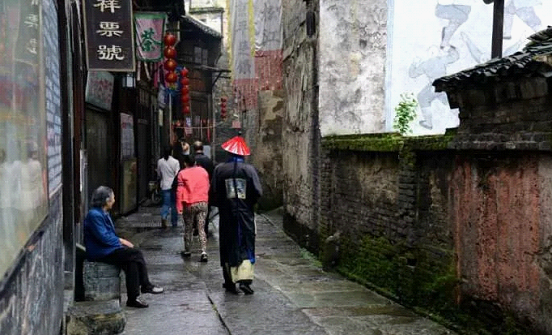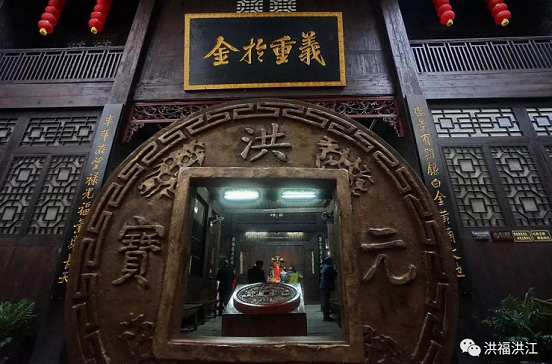Since the late Ming and early Qing dynasties, Hongjiang Ancient Commercial Town had been an important trading port on the borders of Hunan and Guizhou, known as the “Thoroughfare to Seven Provinces”. Commercial trade was frequent, with substantial financial transactions taking place. To make efficient use of funds, accelerate capital turnover, and ensure the safety of financial assets, a financing industry centered on private currency operation—money shop—emerged in response to the objective demands of the market economy.

The earliest money shops in Hongjiang were founded in the third year of the Guangxu reign (1877), with Hemao and Zhongfu being the first two. By the thirty-first year of the Guangxu reign (1905), the money shop industry experienced rapid growth, reaching a total of 21, with a capital of 41,000 yuan (silver dollars) and issuing silver notes worth 12,800 yuan (silver dollars). In 1914, there were 23 money shops of various sizes.

The renowned money shops included Qingrongxiang, Linshuntai, Qianyifeng, Yuzhuangchang, Hongji, Jintaixiang, Kaiyuanhe, Changchuntang, and Deshengchang. Among them, Hongji Money Shop was wholly owned by a wealthy individual from Changsha (with the surname Zhang) and was well-capitalized. It established branches in Hankou, Chongqing, Chengdu, and Shanghai, allowing for capital transfers between branches. Its good reputation and financial credibility earned the trust and praise of business people, leading to substantial operational profits. However, some money shops performed poorly and lacked integrity. For example, Qianyifeng Money Shop was founded by Li Zhenxiang from Xiangxiang County. It colluded with the warlord Chen Hanzhang, claiming to have a capital of 300,000 yuan (silver dollars) and achieving considerable notoriety at the time. However, following an internal conflict between Chen and his subordinates, resulting in Chen’s assassination, the money shop seized the opportunity to transfer funds and fled with the money, ultimately leading to its collapse. This left other money shops like Qingyuanfeng severely affected, incurring significant losses.

The money shops primarily engaged in deposit, loan and foreign exchange businesses. Most deposits came from merchants and individuals. Loans were offered in four forms: credit, collateral, overdraft, and interbank borrowing. Loan interest rates could reach as high as 3% and drop as low as 0.3%, fluctuating based on the availability of silver at the time. Transfer of funds included three types: remittance by banker’s demand draft, mail transfer, and telegraphic transfer. The handle fee for telegraphic transfer was relatively high, around 0.5%, but these were favored by the business community due to its speed, safety, and reliability. There was also a special method of fund transfer known as “making a note”, primarily used by traveling merchants and representatives of businesses from other regions stationed in Hongjiang. In cases where cash was urgently needed for purchasing goods but funds were temporarily unavailable, they would issue promissory notes to the money shops to borrow cash, specifying the amount, payment date, and name of the business on the notes. This borrowing method carried significant risks and high interest rates, ranging from 5% to 20%. In addition to money shops, financially strong businesses often operated in this field, with the total annual borrowing exceeding 10 million yuan (silver dollars).
According to a report in 1920, “Hongjiang is the largest town upstream on the inland river... with major money shops such as Yutongxiang, Yutongheng, Yifukang, and Jiudazhuang, engaging in money transfer throughout the country. During each settlement period (the 15th and the end of each lunar month), the total remittance amounts to several hundred thousand yuan with money shops in Hankou and Zhenjiang.” Chinese Industrial Chronicle recorded in 1933 that the currency circulation in Hongjiang ranked second in Hunan Province, only behind Changsha.
In the thirty-fourth year of the Guangxu reign (1908), the Hongjiang Bureau of Official Money Exchange was established; it was renamed the Hongjiang Branch of Hunan Provincial Bank in the first year of the Republic of China (1912). In 1933, Hunan Provincial Bank set up remittance offices in Hongjiang, gradually replacing the remittance business of money shops. Consequently, the number of money shops began to decline. By 1934, only Hongji, Kaiyuanhe, Yuqingchang, Tongyihe, Deshengchang, Changchunrong and Rongfeng remained, with a total capital of 460,000 yuan (silver dollars).
After the outbreak of the War of Resistance against Japanese Aggression, starting in 1939, various banks established branches or offices in Hongjiang, leading to a thriving financial industry. These new banks took over the deposit, loan, and foreign exchange businesses of the money shops, and their safety and credit significantly surpassed those of the money shops. Therefore, amid fierce competition, the money shops gradually declined, ceased operations, and ultimately closed.
(Translated by Yang Hong)
